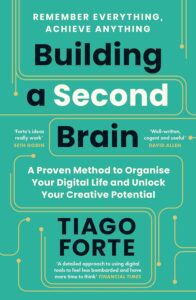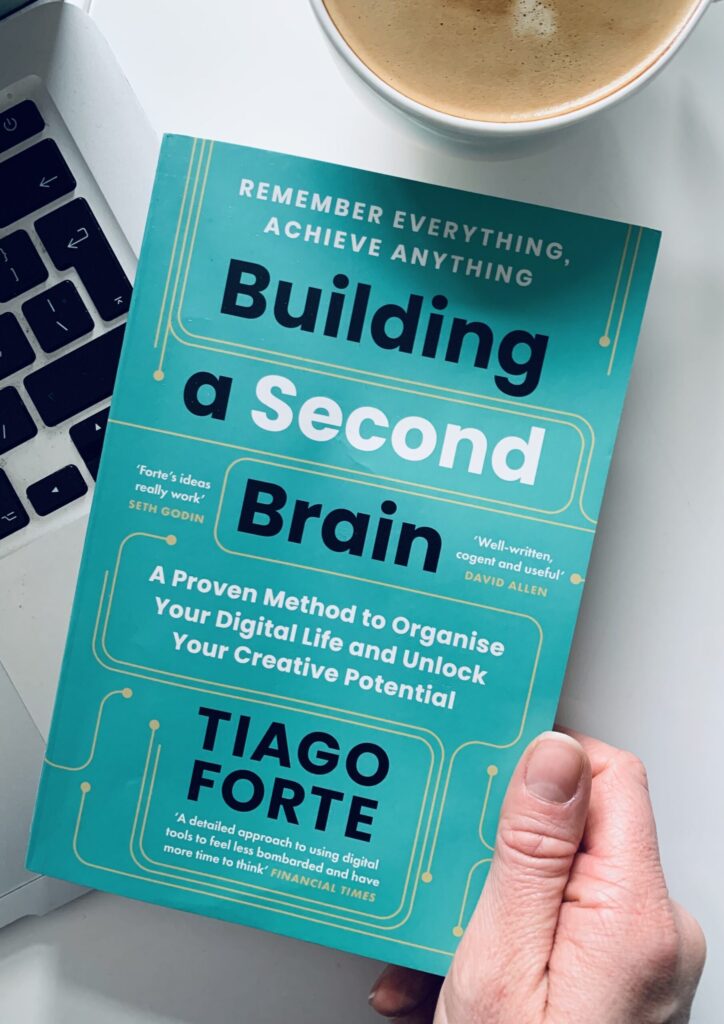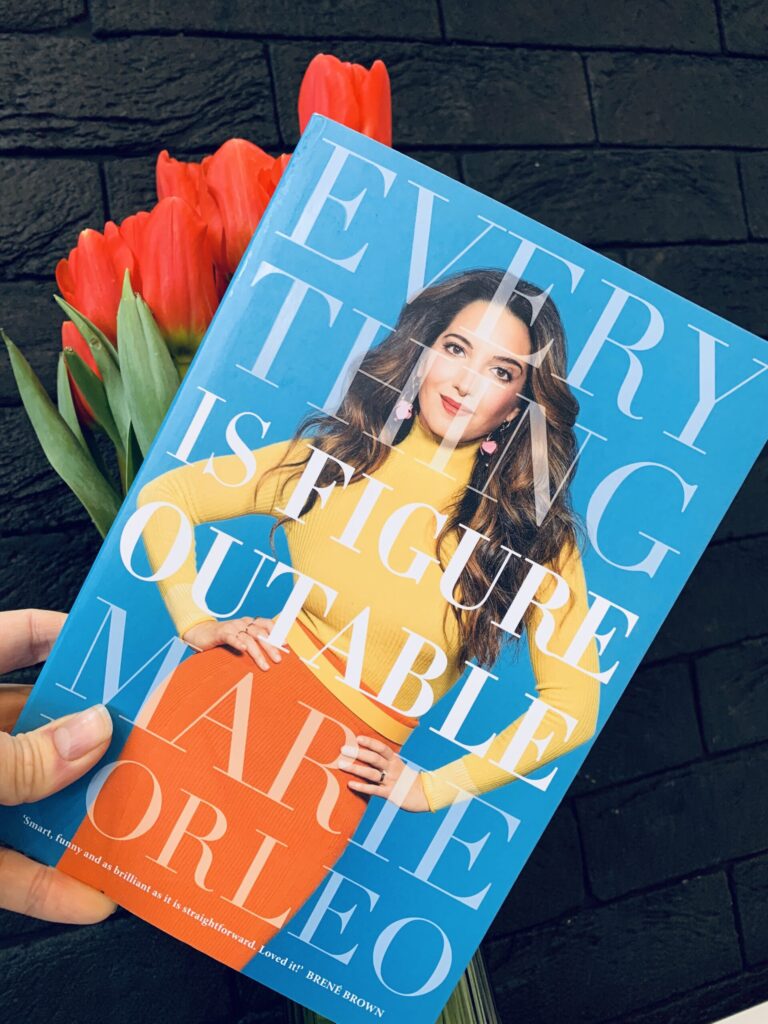 Building a Second Brain. Book Summary
Building a Second Brain. Book Summary
A Proven Method to Organise Your Digital Life and Unlock Your Creative Potential
Tiago Forte
Profile Books; Main edition (3 Aug. 2023)
About The Author
Tiago Forte is one of the world’s foremost experts on productivity and has taught thousands of people around the world how timeless principles and the latest technology can revolutionize their productivity, creativity, and personal effectiveness. He has worked with organizations such as Genentech, Toyota Motor Corporation, and the Inter-American Development Bank, and appeared in a variety of publications, such as The New York Times, The Atlantic, and Harvard Business Review.
About The Book
“According to the New York Times, the average person’s daily consumption of information now adds up to a remarkable 34 giga-bytes. A separate study cited by the Times estimates that we consume the equivalent of 174 full newspapers’ worth of content each and every day, five times higher than in 1986.
Instead of empowering us, this deluge of information often overwhelms us. Information Overload has become Information Exhaustion, taxing our mental resources and leaving us constantly anxious that we’re forgetting something. Instantaneous access to the world’s knowledge through the Internet was supposed to educate and inform us, but instead it has created a society-wide poverty of attention.
Research from Microsoft shows that the average US employee spends 76 hours per year looking for misplaced notes, items, or files. And a report from the International Data Corporation found that 26 percent of a typical knowledge worker’s day is spent looking for and consolidating information spread across a variety of systems.’ Incredibly, only 56 percent of the time are they able to find the information required to do their jobs.
In other words, we go to work five days per week, but spend more than one of those days on average just looking for the information we need to do our work. Half the time, we don’t even succeed in doing that.
It’s time for us to upgrade our Paleolithic memory. It’s time to acknowledge that we can’t “use our head” to store everything we need to know and to outsource the job of remembering to intelligent machines. We have to recognize that the cognitive demands of modern life increase every year, but we’re still using the same brains as two hundred thousand years ago, when modern humans first emerged on the plains of East Africa.
Every bit of energy we spend straining to recall things is energy not spent doing the thinking that only humans can do: inventing new things, crafting stories, recognizing patterns, following our intuition, collaborating with others, investigating new subjects, making plans, testing theories. Every minute we spend trying to mentally juggle all the stuff we have to do leaves less time for more meaningful pursuits like cooking, self-care, hobbies, resting, and spending time with loved ones.
However, there’s a catch: every change in how we use technology also requires a change in how we think. To properly take advantage of the power of a Second Brain, we need a new relationship to information, to technology, and even to ourselves.”
In today’s information age, mastering your personal knowledge is crucial for both productivity and creativity. We’re bombarded with data, and without a system to capture, remember, and leverage it, valuable insights slip through the cracks. While technology can be a double-edged sword, Tiago Forte’s Building a Second Brain empowers you to harness its potential.
Forte’s approach is simple and actionable. He guides you through creating your own personalized knowledge management system, essentially a “second brain” that amplifies your thinking and learning. This quick and engaging read offers practical steps you can implement immediately, with additional resources to jumpstart your journey.
Now, let’s explore some of my key takeaways.
P.S.: Love Building a Second Brain? You might also enjoy Limitless by Jim Kwik, Irresistible by Adam Alter and Bored and Brilliant by Manoush Zomorodi – check out our notes!
Key Insights
CODE Method – The Four Steps to Remembering What Matters
“To guide you in the process of creating your own Second Brain, I’ve developed a simple, intuitive four-part method called “CODE” – Capture; Organize; Distill; Express.
These are the steps not only to build your Second Brain in the first place, but also to work with it going forward. Each of these steps represents a timeless principle found throughout humanity’s history, from the earliest cave paintings to the artisan workshops of the Renaissance to the most cutting-edge modern fields. They are flexible and agnostic for any profession, role, or career and for whatever note-taking methods and platforms you prefer.”
Imagine a digital version of Leonardo Da Vinci’s notebooks, where all your ideas, observations, and insights are meticulously organized and readily accessible. That’s essentially your Second Brain. Instead of relying solely on your own memory, this system empowers you to leverage technology to build a vast knowledge library and retrieve specific information effortlessly.
Our Second Brain has four superpowers. It can help us:
- Make our ideas concrete.
- Reveal new associations between ideas.
- Incubate our ideas over time.
- Sharpen our unique perspective.
Now, to build our Second Brain and make it our super powerful personal assistant, we need a proper system in place. The CODE method provides a clear roadmap for harnessing the power of your Second Brain:
- Capture: Gather information from various sources using a note-taking app (Forte provides app recommendations on his website).
- Organize: Implement the PARA system (Projects, Areas, Resources, Archives) to categorize and store your notes efficiently.
- Distill: Extract the key essence and insights from each note.
- Express: Share your knowledge through writing, teaching, or other creative projects.
Let’s have a quick look at big ideas.
Twelve Favorite Problems Approach
“With the abundance of content all around us, it can be hard to know exactly what is worth preserving. I use an insightful exercise to help people make this decision easier. I call it “Twelve Favorite Problems,” inspired by Nobel Prize-winning physicist Richard Feynman. […]
… Feynman’s approach was to maintain a list of a dozen open questions. When a new scientific finding came out, he would test it against each of his questions to see if it shed any new light on the problem. This cross-disciplinary approach allowed him to make connections across seemingly unrelated subjects, while continuing to follow his sense of curiosity. […]
Feynman’s approach encouraged him to follow his interests wherever they might lead. He posed questions and constantly scanned for solutions to long-standing problems in his reading, conversations, and everyday life. When he found one, he could make a connection that looked to others like a flash of unparalleled brilliance.
Ask yourself, “What are the questions I’ve always been interested in?” This could include grand, sweeping questions like “How can we make society fairer and more equitable?” as well as practical ones like “How can I make it a habit to exercise every day?” It might include questions about relationships, such as “How can I have closer relationships with the people I love?” or productivity, like “How can I spend more of my time doing high-value work?” […]
Use your list of favorite problems to make decisions about what to capture: anything potentially relevant to answering them.”
So, you’ve got your note-taking app ready to roll. But before you start capturing everything that crosses your path, let’s talk about what deserves a place in your Second Brain.
The concept of the Twelve Favorite Problems offers a brilliant solution. It reminds me of the Hundred Questions Exercise from Michael Gelb’s book Think Like Leonardo DaVinci. It encourages you to identify 12 open-ended questions that represent your current interests and aspirations. These become your personal filters, guiding you to capture information relevant to your unique trajectory. Think of them as your personal research agenda.
Instead of passively consuming information, these questions turn you into an active hunter of insights. Every article, book, or conversation becomes a potential answer to your personal quests. It’s a powerful shift, transforming your note-taking from a passive act to a strategic pursuit of knowledge.
But there’s more to it than just questions. Forte also provides the Capture Criteria to help you decide what resonates with you:
- Does it inspire me?
- Is it useful?
- Is it personal?
- Is it surprising?
- Ultimately, capture what resonates!
Remember, your Second Brain isn’t a graveyard of forgotten notes. Capture information with intention, ask yourself, “How can this benefit my future self?” and watch your knowledge base transform into a potent resource for growth and creativity.
That leads us to the next insight.
PARA Organizing System
“PARA can handle it all, regardless of your profession or field, for one reason: it organizes information based on how actionable it is, not what kind of information it is. The project becomes the main unit of organization for your digital files. Instead of having to sort your notes according to a complex hierarchy of topics and subtopics, you have no answer only one simple question: “In which project will this be most useful?” It assumes only that you are currently working on a certain set of projects, and that your information should be organized to support them. […]
Instead of organizing ideas according to where they come from, I recommend organizing them according to where they are going-specifically, the outcomes that they can help you realize. The true test of whether a piece of knowledge is valuable is not whether it is perfectly organized and neatly labeled, but whether it can have an impact on someone or something that matters to you.”
Ever feel like your notes are scattered across the digital landscape, lost in a maze of folders and tags? Tiago Forte’s PARA system, a core component of his CODE method, offers a brilliant solution. Forget the random topic-based organization struggle, and instead, categorize your notes into four distinct buckets:
1. Projects: “Short-term efforts in your work or life that you are working on now.” These can be projects at work (e.g. client proposal, creating slide deck for conference, web-page design), personal projects (e.g. trips, moving houses, finishing a language course) or any other side projects (publishing a blog post, volunteering project)
2. Areas: “Long-term responsibilities you want to manage over time.” Examples are activities or places you are responsible for (home, cooking, travel, car, account management, marketing, operations); people you are responsible for (parents, kids, spouse, pets, suppliers, board of directors, direct reports); Standards of performance you are responsible for (personal growth, health, finance, marriage, professional development, relationships and networking, recruiting and hiring);
3. Resources: “Topics or interests that may be useful in the future.” That’s what doesn’t fit into any of the projects and includes any topic you are interested in gathering information about. Any hobbies/topics (architecture, beer brewing), subjects you are researching (habit formation, nutrition, project management), or other useful info that you’d like to reference (life goals, vacation itineraries, reading lists, etc.)
4. Archives: “Inactive items from the other three categories.” All the completed projects, areas of responsibility that you are no longer committed to maintaining or resources that are no longer relevant. That’s like cold storage – you can still access your notes if you need them, but they don’t clog your workspace and don’t block your creativity.
The beauty of PARA lies in its flexibility. It adapts to your unique needs and evolves as your life does. No more endless scrolling through disorganized notes! Instead, enjoy a streamlined digital space that fosters creativity and boosts productivity.
When I looked at my notes, I realised I was a capture champion but an organization laggard. However, after implementing PARA in my Notion workspace, transformation magic happened! Now, I navigate my notes with ease, saving time and mental energy.
You should give it a try!
Progressive Summarization
“Progressive Summarization is the technique I teach to distill notes down to their most important points. It is a simple process of taking the raw notes you’ve captured and organized and distilling them into usable material that can directly inform a current project.
Progressive Summarization takes advantage of a tool and a habit that we are all intimately familiar with—highlighting—while leveraging the unique capabilities of technology to make those highlights far more useful than anything you did in school.
The technique is simple: you highlight the main points of a note, and then highlight the main points of those highlights, and so on, distilling the essence of a note in several “layers.” Each of these layers uses a different kind of formatting so you can easily tell them apart.”
Love it. That’s pretty much my approach to my book notes. However, I’ve come to realize the importance of incorporating more formatting (which I promptly experimented with in these notes). It’s a simple yet impactful concept.
Here’s my note-taking process: I first highlight the key ideas from the book, then sift through the raw material to pinpoint the ideas that really resonate with me. Finally, I condense these insights into approximately six pages. Additionally, I append three actionable points at the conclusion to facilitate immediate implementation.
Use Your Second Brain to Create
“Our time and attention are scarce, and it’s time we treated the things we invest in-reports, deliverables, plans, pieces of writing, graphics, slides – as knowledge assets that can be reused instead of reproducing them from scratch. Reusing Intermediate Packets of work frees up our attention for higher-order, more creative thinking. Thinking small is the best way to elevate your horizons and expand your ambitions.
There are five kinds of Intermediate Packets you can create and reuse in your work:
– Distilled notes: Books or articles you’ve read and distilled so it’s easy to get the gist of what they contain (using the Progressive Summarization technique you learned in the previous chapter, for example).
– Outtakes: The material or ideas that didn’t make it into a past project but could be used in future ones.
– Work-in-process: The documents, graphics, agendas, or plans you produced during past projects.
– Final deliverables: Concrete pieces of work you’ve delivered as part of past projects, which could become components of something new.
– Documents created by others: Knowledge assets created by people on your team, contractors or consultants, or even clients or customers, that you can reference and incorporate into your work.”
Imagine your notes not just as passive collections of information, but as potent building blocks for your creativity. Tiago Forte calls these blocks Intermediate Packets. Think of them like Lego blocks – the more you have, the easier it is to build something interesting.
But how do we utilize these packets to spark our creative fires? Here are three powerful strategies from the book:
- Archipelago of Ideas: Build bridges between your ideas – outline, mind map, or list them – for a clear path from one thought to the next.
- Hemingway Bridge: Carry your momentum from one day to the next – bridge your workflow! Capture the next steps, project status, and key details at the session end to jump right back in next time.
- Dial Down the Scope: Big project? Make it bite-sized! Break it down into smaller, achievable tasks for smoother progress and less overwhelm.
And remember, your notes are not just passive records; they are the raw materials for your creative projects. By applying these strategies, you can unlock the potential within your notes and transform them into remarkable creations that inspire, inform, and leave your mark on the world.
Action Steps For You
1. Start taking notes. Instead of relying solely on your memory, use note-taking apps (Forte recommends some on his website) to capture any ideas, insights, or inspiration that strikes you. This could be anything from fleeting thoughts to project plans to random observations.
2. Implement the PARA system. This system categorizes your notes into Projects (active tasks), Areas (long-term responsibilities), Resources (future-focused information), and Archives (completed projects/inactive resources).
3. Master Progressive Summarization. This technique involves highlighting key points in your notes, then highlighting the highlights, and so on, until you reach the core essence. Each layer of highlights uses different formatting for easy identification.
Quotes From The Book:
“Your efforts to capture content for future use will be tremendously easier and more effective if you know what that content is for. Using PARA is not just about creating a bunch of folders to put things in. It is about identifying the structure of your work and life— what you are committed to, what you want to change, and where you want to go.”
“As you build your Second Brain, you will collect many facts and figures, but they are just a means to an end: discovering the tacit knowledge that lives within you. It’s in there, but you need external hooks to pull it out and into your conscious awareness. If we know more than we can say, then we need a system for continuously offloading the vast wealth of knowledge we’ve gained from real life experience.”
“When you are captivated and obsessed by a story, an idea, or a new possibility, don’t just let that moment pass as if it doesn’t matter. Those are the moments that are truly precious, and that no technology can produce for you. Run after your obsessions with everything you have. Just be sure to take notes along the way.”
“It’s crucial to stay organized, but it needs to be done a little at a time in the flow of our normal lives. It needs to be done in the in-between moments of moving your projects forward as you notice small opportunities for improvement.”
“When we are organized and efficient, that creates space for creativity to arise. When we have confidence in our creative process, we don’t have to think about it as much, significantly reducing the background stress of constantly worrying whether were going in the right direction.”
“To be able to make use of information we value, we need a way to package it up and send it through time to our future self. We need a way to cultivate a body of knowledge that is uniquely our own, so when the opportunity arises—whether changing jobs, giving a big presentation, launching a new product, or starting a business or a family—we will have access to the wisdom we need to make good decisions and take the most effective action. It all begins with the simple act of writing things down.”



